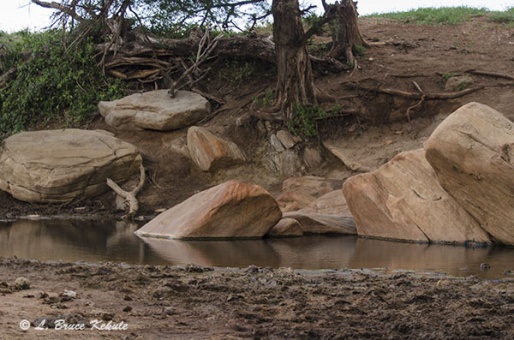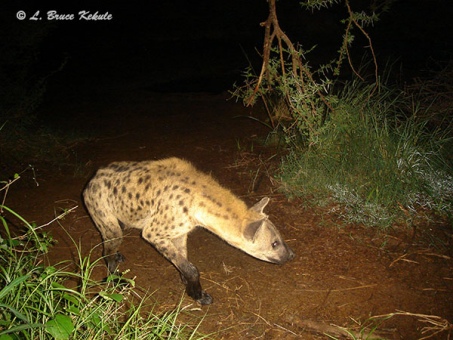Archive for June, 2012
Sony W7 trail cam traps African elephant, giraffe and a bushbaby..!
More camera trapping in Kenya
Elephants and egrets in Amboseli National Park by the side of the road
For the last three years, I have made an annual photographic safari to Africa catching the ‘bug’ as they say. On my first trip in September 2010, I did not take any camera traps along but concentrated on ‘through the lens’ work. It was simply amazing seeing and photographing so many animals including the ‘Big Five’. I was with a group of Thai photographers. After visiting a few of the top protected areas in Kenya for 12 days, and taking more than 90 gigabytes worth of images, you can say I’m now addicted to this place.
In August 2011, I headed a new group of Thai photographers on safari. This time I took a few camera traps hoping to set them in the bush. The first hotel was a tented camp near the famous Masai Mara National Reserve (where the wildebeest and zebra cross the crocodile infested Mara River). The camp has wildlife running all over the place including the rare bushbuck, an antelope found in only a few places in Africa. Other creatures include mongoose and genet. See my previous thread entitled ‘Camera trapping in Africa’.
This year in May, I went to Kenya once again but this time down south to some new locations including Amboseli National Park near Mount Kilimanjaro on the border with Tanzania, and then to Tsavo (west and east) national parks (together they form the largest national park in the world), plus Shimba Hills Wildlife Sanctuary near the coast at Mombasa, and finally Taita Wildlife Sanctuary on my way back to Nairobi. It was once again terrific seeing and photographing some incredible creatures of nature.
Giraffes in Tsavo (West) National Park
This year I also took a W7/1010/SS1 cam with one of my custom ‘elephant proof-boxes’ as a double or back up to the Sony S600 trail cam mentioned in previous stories. Tough restrictions made it difficult to set them up. But at one location in Amboseli NP, there was a tree right next to the road and I quickly got down from the ‘Land Cruiser’ and slipped it on with a ‘Python’ cable with my camouflage sleeves and stuck some grass and leaves around it to break-up the outline.
I left it for two nights and picked it up on the way out of the park. Low and behold, two elephants had passed the cam. The distance was considerable but the sensor still got one shot in good light. I was pleased. We then headed to Tsavo (West) national park for a three-hour drive.
As we moved into the reserve, I found a tree with loads of ungulate tracks crossing the road. It was the same drill: get down and throw the cam on quickly with a Python cable and sleeves. I let this one soak for two nights and picked it up on the way out. A couple of giraffes were caught nibbling on some leaves and the W7 worked well. We then moved further East and I caught elephants but they were reddish from the red-colored clay soil found here.
Elephants in Tsavo (East) National Park: note reddish color from clay found here
We then motored down to what I would say is one of the worst roads I have ever traveled on in my entire life. For more than thirty kilometers, the road was potholed with some large enough to swallow a small car. Hundreds of truck trailers moving in and out of Mombasa on a daily basis (Kenya’s main port on the Southern coast) have destroyed the road and causes huge traffic jams.
It was hell getting through but my driver Patrick Mjoroge was very skilled having driven safari vehicles for more than 25-years. He knew how to weave in and out but I stayed ‘white-knuckled’ for most of the way. I tried to stay cool no matter what the conditions were but it was nerve-racking to say the least.
Male ‘bushbaby’ at the Shimba Hills Resort bar
We finally reached my 4th destination on this trip at Shimba Hills Wildlife Sanctuary past Mombassa. Being near the coast, it was lush and green unlike the hot dusty plains inland. The forest was thick but due to frequent patrols by rangers, I could not slip a cam in.
That night as Patrick and I were having our sun-downers and dinner, a male ‘bushbaby’ showed up at the bar. I immediately went to my room and got the W7. These small primates are semi-habituated and addicted to bread. I set-up my cam and left some bait. It did not take long to capture some candid camera trap shots.
Bushbaby: one of Africa’s smallest primates
In the event I travel to Africa again, I will surely be taking a couple DSLR trail cams and a few video cams. The opportunity to trap Africa’s exotic creatures on digital is great and I look forward to visiting Kenya once again. I hope those interested will enjoy this thread.
Camera trapping in Tsavo (West) National Park, Kenya
Trail Camera catches hyena, waterbuck, impala and baboon
Sony S600 trail camera at a stream in Tsavo (West) National Park
Before I departed for my annual safari to Kenya during May of this year, I decided to take my trusty Sony S600 trail cam with a Snapshotsniper SSII board in a Pelican 1010 case hoping to put it out in the field.
Stream in the interior of Tsavo (West) National Park
It is small and I knew I could depend on it to catch some interesting wildlife shots. Prior to trapping my ‘ghost leopard’ in Tsavo (East) with this cam, I visited Tsavo (West) National Park, southern Kenya.
Camera trapper testing S600 trail cam
One day while out on a ‘game drive’, my driver/guide Patrick Mjoroge and I stopped for a pit stop near a bend in a small stream close to the road deep in the interior. I got out to stretch my legs and walked on down to have a look around. There was a large group of baboons nearby and they were headed our way.
Waterbuck passing the cam on the first night
There were several trees next to what looked like a game trail by the little waterway so I quickly set-up the S600 using a ‘Python’ locking cable with my camouflage sleeves in conjunction with a ‘Snapshotsniper’ Pelican case locking bracket. I threw down some salami, meat and bread from dinner the previous night as bait. It was worth a try. We departed and left the cam for an overnight soak.
Hyena on the first night eating the bait
The next morning, we returned to the stream to check on the cam and for a boxed breakfast packed by the hotel consisting of two hard-boiled eggs, some bacon, sausage, bread, butter and jam, an apple, some juice and water. It was better than nothing but my mandate was to leave at dawn for early morning light, and since we were at least thirty kilometers away from the hotel, breakfast was out of the question.
Baboons caught on the second afternoon
The bread was not that good and the bacon was cold and greasy, so I decided to top-up the bait left the previous afternoon and left the cam out for one more night. No one could see the set-up from the road and I knew it was safe.
The same hyena the second night
The next morning as we were leaving the park to go further east, we headed straight to the stream to pick-up the cam. As I scrolled through the images, it was evident the bait had worked extremely well. A hyena visited the first night and ate everything except the salami (weird), and then came again the next night for the bacon and bread. I was extremely happy when I also saw a waterbuck, impala and baboon walking past the cam.
Impala passing the cam on the second day
Wherever there are baboons, there are leopards. I vowed that if I ever return to this place, I’ll bring one of my DSLR camera traps plus a small video-unit like a Bushnell Trophy Cam or one of my homebrew video units. Success is always sweet and I hope everyone enjoys this set-up.





















